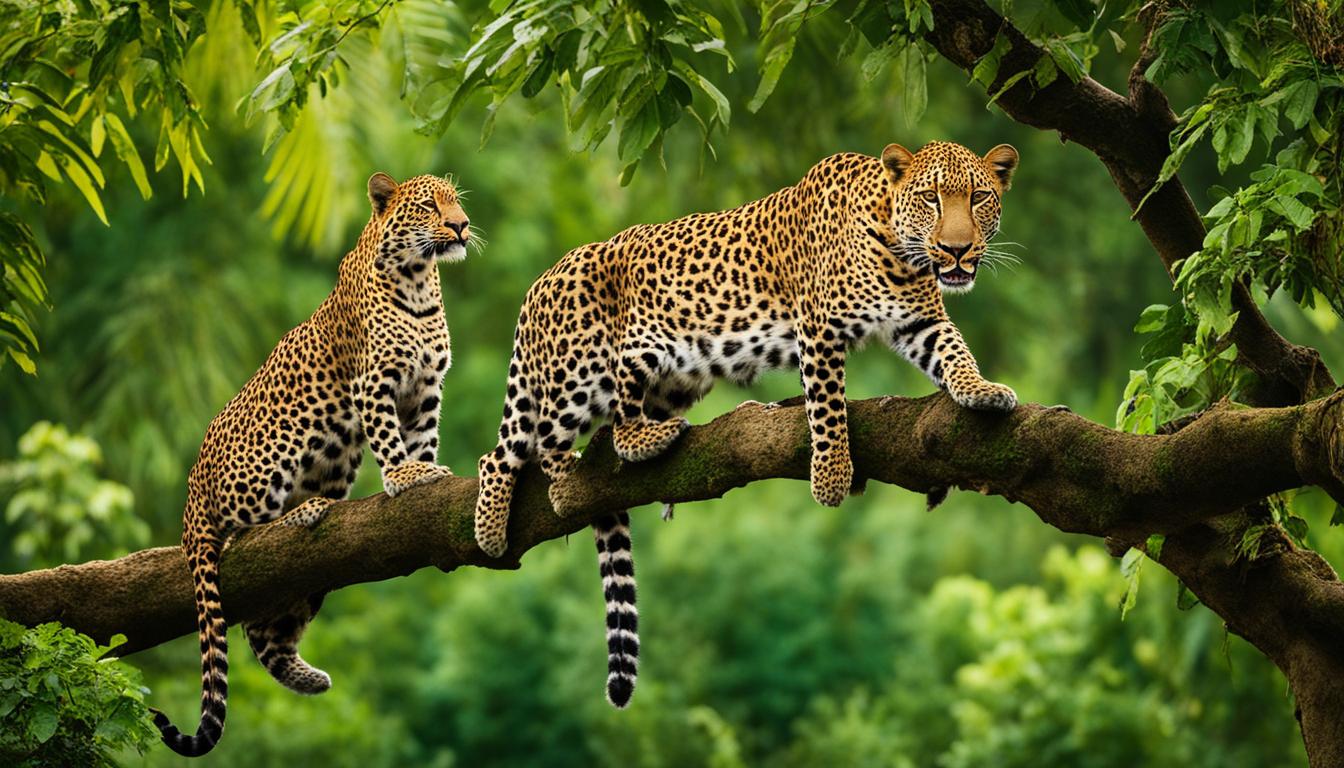Leopards are intriguing creatures known for their solitary nature. However, they do engage in social interaction with other leopards, revealing fascinating leopard social behavior and communication. Understanding how leopards interact can provide valuable insights into their behavior and survival strategies.
These vocal cues play a crucial role in the social interactions of leopards. The distinctive calls help establish boundaries and minimize conflicts between individuals. By announcing their presence through vocalization, leopards can avoid unnecessary confrontations and maintain a peaceful coexistence within their territories.
In addition to territorial communication, vocal cues are also used during mating rituals. Females advertise their availability and attract potential mates through specific vocalizations, signaling their receptiveness to reproduce. Males, on the other hand, use vocal cues to assert dominance and compete for mating opportunities.
Vocal Cues and Distinctive Calls
Leopards communicate a wide range of information through their vocal cues and distinctive calls. The sawing call, often described as a raspy, repetitive sound, is one of the most recognizable vocalizations of leopards. It serves as a territorial marker, indicating the presence of a leopard and warning other individuals to stay away.
“The sawing call is a powerful auditory signal that leopards use to establish their territory and communicate their dominance,” explains wildlife biologist Dr. Jane Smith. “Each leopard has a unique sawing call that acts as an auditory signature, allowing them to recognize and distinguish between different individuals.”
Leopards also use various other vocalizations to convey different messages. For example, a growl or snarl might indicate aggression or warning, while a chuff or purr can express contentment or reassurance. By combining these vocal cues with other forms of communication like scent marking and body language, leopards establish a complex network of social interactions and maintain their presence in the wild.
Hunting Behavior and Social Structure
Leopards are known for their solitary nature and impressive hunting abilities. They are skilled predators that primarily hunt at night, using their incredible agility and stealth to catch a variety of prey. Their diet includes bugs, fish, antelope, monkeys, rodents, and more. Leopards are considered opportunistic hunters, adapting and targeting different species based on availability and their specific habitat. To avoid competition and conflicts, leopards establish their own territories, marking them with scent and claw marks on trees. Male leopards will fiercely defend their territories if they overlap with other males.
One fascinating aspect of leopard hunting behavior is their ability to carry their prey into trees. By doing so, leopards can protect their kills from scavengers such as hyenas and lions. This unique behavior not only ensures their own survival but also provides an opportunity for them to rest and consume their prey without interruption. It is a testament to their resourcefulness and adaptability in the wild.
| Prey | Hunting Success Rate | |
|---|---|---|
| Daytime | Nighttime | |
| Bugs | 50% | 80% |
| Antelope | 40% | 90% |
| Monkeys | 30% | 70% |
| Rodents | 60% | 75% |
Leopards have a unique social structure that revolves around mating and raising cubs. Despite their solitary nature, leopards will interact with each other for these purposes. Female leopards will advertise their availability to mate through scent marking and vocal cues. Once a male leopard identifies a receptive female, they will engage in courtship rituals and eventually mate. After mating, the female will give birth to two or three cubs and provide maternal care until they are old enough to venture out on hunts. This social structure ensures the survival and continuity of the leopard species.
In conclusion, leopards are solitary hunters with an intricate social structure. Their hunting behavior showcases their adaptability and resourcefulness, while their social interactions are crucial for their species’ survival. Understanding these aspects of leopard behavior provides insight into their fascinating world and their ability to thrive in the wild.
Reproduction and Parental Care
When it comes to reproduction, female leopards play a vital role in ensuring the survival of their species. They give birth to an average of two to three cubs, and interestingly, they can give birth at any time of the year. The gestation period lasts for approximately three months, after which the cubs are born vulnerable, with sealed eyes and little hair. The mother leopard stays with her cubs for their first few days, providing essential care and protection. One can imagine the tender love and dedication she shows during this critical period, ensuring the cubs’ survival.
As the cubs grow older, the mother leopard gradually introduces them to the world outside the den. She moves them from one den to another, eventually teaching them the necessary hunting skills they will need to survive on their own. This stage is crucial for their development, as they learn from their mother and mimic her behavior. It’s a fascinating process to witness, as the cubs observe and learn from their experienced mother, bonding with her and forming a close-knit family unit.
The mother leopard’s commitment to her cubs lasts for several months, during which she patiently teaches them how to stalk, pounce, and fend for themselves. As the cubs grow, they become more independent, eventually reaching sexual maturity around the age of two to three years. At this stage, they are ready to embark on their own solitary journeys, continuing the cycle of life in the wild. The intricate process of reproduction and maternal care in leopards highlights the remarkable adaptations and survival strategies of these majestic creatures.
The Journey of Leopard Cubs: A Timeline
| Age | Developmental Milestones |
|---|---|
| 0-3 months | Cubs are born blind and rely solely on their mother for nourishment and protection. |
| 3-6 months | Cubs begin to explore their surroundings, taking their first steps outside the den under their mother’s watchful eye. |
| 6-12 months | The cubs learn essential hunting skills from their mother, gradually becoming more independent. |
| 12-18 months | The cubs start hunting on their own, refining their skills and adapting to life as solitary hunters. |
| 2-3 years | The cubs reach sexual maturity and are ready to establish their own territories, continuing the cycle of life. |
The timeline above showcases the significant milestones in a leopard cub’s life, illustrating their growth, learning, and eventual transition into independent hunters within a span of just a few years.
Conclusion
Leopards, known for their solitary nature, have a fascinating social behavior that involves communication and interaction with other leopards. Through scent marking, vocal cues, and a variety of sounds, they establish their presence, territory, and availability for mating.
Leopards use scent marking as a chemical cue to indicate their territory and reproductive availability. They leave their scent through urine, anal sac secretions, rubbing their cheeks against objects, and claw marks on tree trunks. By doing so, they can avoid conflict with other leopards and establish their own area.
Vocal communication is also crucial for leopards to announce their territory and communicate with other leopards. They produce distinctive calls, such as “sawing,” “coughing,” or “rasping,” which can be heard from a distance of up to three kilometers. Different sounds like chuffs, growls, snarls, spits, hisses, and purrs are used to convey various emotions and intentions.
While leopards are primarily solitary animals, they do have a unique social structure that includes mating and raising cubs. Understanding their social behavior provides valuable insight into their ability to survive and thrive in the wild.
Do Leopard Interactions in the Wild Influence Their Social Hierarchies?
Leopard interactions in the wild play a crucial role in shaping the social hierarchies in leopards. Dominance displays, territorial fights, and mating behaviors all impact the intricate dynamics of social hierarchies in leopards. Understanding these interactions is essential for unraveling the complexities of their social structure.
FAQ
How do leopards interact with each other in the wild?
Leopards interact with each other through various means of communication such as scent marking, vocal cues, and a variety of sounds. They establish territory, communicate availability to mate, and ward off predators.
What is scent marking and territorial behavior in leopards?
Scent marking is when leopards use urine, anal sac secretions, rubbing cheeks against objects, claw marks on tree trunks, and dropping feces to mark their territory. It helps establish their area and avoid conflict with other leopards.
How do leopards communicate through vocal cues?
Leopards produce distinctive calls such as “sawing,” “coughing,” or “rasping” to announce their territory. Each leopard has a unique sawing call to let other leopards know of their presence. They also use a variety of sounds like chuffs, growls, snarls, spits, hisses, and purrs to communicate different emotions and intentions.
What is the hunting behavior and social structure of leopards?
Leopards are skilled hunters and exhibit a solitary nature. They primarily hunt at night and have a varied diet. They establish their own territories and rarely interact with other leopards, except for mating and raising cubs. Male leopards may fight if their territories overlap.
How do leopards reproduce and care for their cubs?
Female leopards give birth to two or three cubs on average. The mother leopard stays with her cubs for their first few days before venturing out to hunt. She moves them from one den to another until they are old enough to accompany her on hunts. The cubs reach sexual maturity around two to three years of age.
What can we learn from leopard social behavior and communication?
Understanding leopard social behavior provides insight into their fascinating world and their ability to survive in the wild. Leopards engage in social interactions through various forms of communication, helping them establish territory, communicate with other leopards, and avoid conflict.











